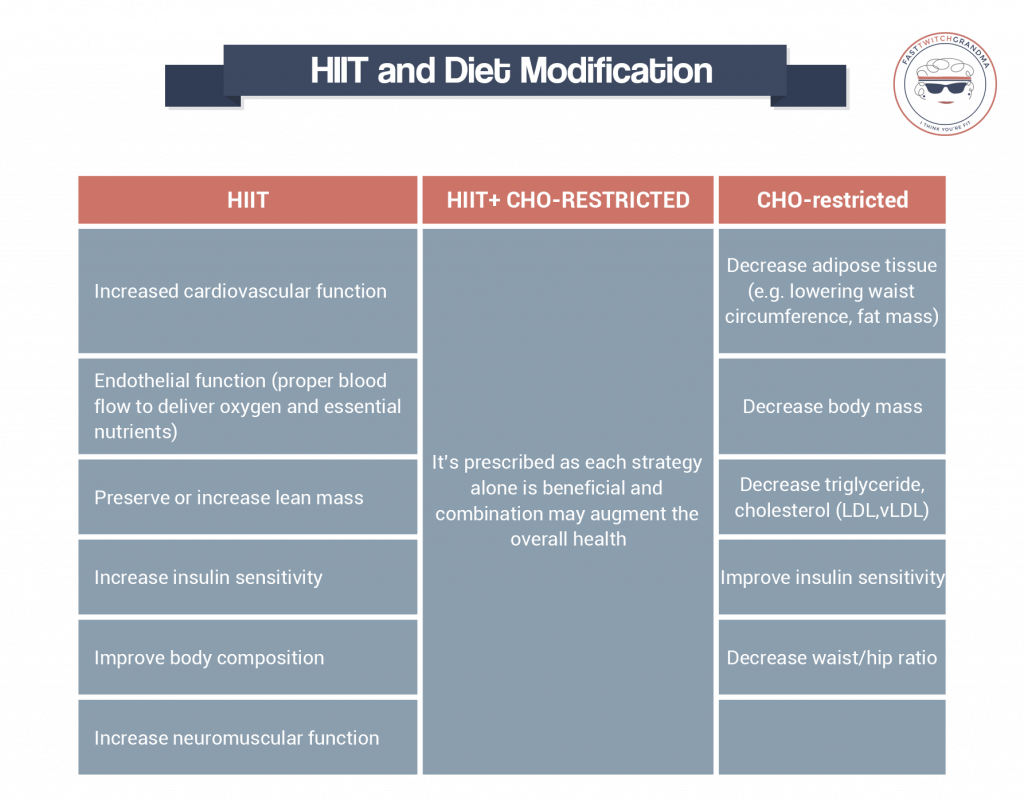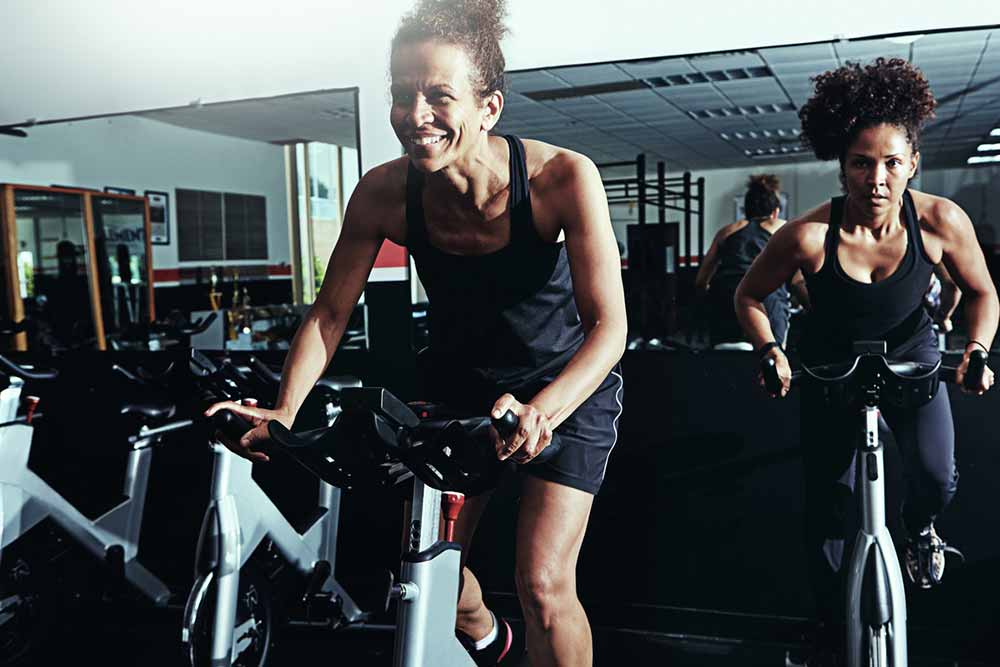Does A Carb Restricted Diet Change HIIT Boost Health Benefits?

Moji Kaviani, Ph.D., CEP
Would carbohydrate restriction diet augment HIIT-induced health benefits?
High intensity interval training has received so much attention because of the benefits of health and exercise performance.
HIIT is a series of high-intensity exercise bouts interspersed with low-intensity exercise for recovery. In addition, there are several dietary modification approaches such as carb restricted diet and intermittent fasting which can have positive impacts on health.
In general, each approach alone has shown to favorably improve some risk factors associated with type 2 diabetes and cardiovascular diseases; however, the combination of HIIT and these dietary modifications has not been extensively investigated. In this regard, restricting carbohydrate can vary ranging from 10% to 40% of total daily energy intake. Also, intermittent fasting generally refers to eating with no limitation (i.e. a ‘feast day’), which alternates with a ‘fast day,’ with reduced food intake. In another form of intermittent fasting, people eat only one meal per day.
When it comes to any lifestyle modification, how long individuals can stick with the plan is crucial. Basically, we are looking for those modifications that are applicable to real life setting. Research has shown that the adherence to both HIIT and CHO restricted diet is reasonable; however, putting this two together still require research with respect to adherence and tolerance.
Related Article: Do Masters Athletes Need Specific Nutrition?
So, the challenge is to what extent we can restrict amount CHO in the diet. This largely depends on the degree of insulin sensitivity in individuals. For instance, people with higher insulin sensitivity would not need to restrict the CHO content as much people with lower insulin sensitivity. Since the prevalence of insulin resistant is almost 35%, it worth considering CHO restriction strategies for additional health benefits particularly for those with type 2 diabetes.
The effective combination of HIIT with a carbohydrate restrictive diet could be a new strategy to treat T2D through lowering fasting blood glucose, insulin resistance, as well as improving body composition and endothelial function (sufficient blood flow to and from the heart through the arteries).
So, if we decide to combine HIIT with carbohydrate-restricted diet, individuals would have to most likely increase their fat intake, which theoretically might work to some extent cancel out the negative impacts of high-fat diet with respect to elevated triglyceride and cholesterol in the bloodstream. This strategy can be tested; however, the timing of carbohydrate consumption might vary in individuals with respect to gender, age, chronic conditions.
There are a number of questions need to be addressed prior to prescribing this strategy to people.
- Degree of carbohydrate restriction and testing the feasibility of it once combined with HIIT
- The most effective HIIT protocol in terms of work/rest ratio. For instance, bouts shorter than 30 s (e.g. 15s, 10s, or 5s) interspersed with shorter recovery time or 30s or longer with extended recovery time.
- using rating of perceived exertion (RPE) as to how difficult the HIIT protocol is felt to see whether is tolerable or not during the carbohydrate-restricted diet.
There was a study showing improvements in cardiometabolic fitness in response to 2 weeks of HIIT consisted of 4× 4-min intervals combined with carbohydrate-restricted diet in obese individuals. In this study, participants followed two weeks of moderate to low-carbohydrate and high-unsaturated fat diet. The degree of carbohydrate restriction was 35% of the total energy intake; where fat and protein intakes were 50 and 15%, respectively.
They concluded that adding HIIT protocol to restricted carbohydrate diet did not augment the loss of fat mass seen in the group without HIIT; however, combined condition showed a greater benefit in preserving lean body mass. This is an important message to those are looking for a fat loss strategy without losing lean body mass as it was shown in previous studies that diet alone likely leads to loss of fat mass as well as lean mass. (Chaston et al. 2007).
Related Article: Concurrent Training & Its Effect on Muscle & Strength Gains
Therefore, adding exercise particularly HIIT protocol appears to be important, at least to preserve lean mass (muscles and bone mineral density) which might adversely affect by diet alone. To support the effectiveness of HIIT protocol on preserving lean mass, Grediagin et al. (1995) reported that high-intensity exercise (80% VO2max) was almost two folds more effective than low-intensity exercise (50% VO2max) in increasing the lean mass.
Takeaway:
A personalized plan should be used to combine HIIT with carbohydrate-restricted diet to ensure that it is well-tolerated. Perhaps, consulting this with your family doctor and dietician should be a great way to start this.
Rating perceived exertion appears to be a better indicator of heart rate to adjust/modify the protocol. For instance, if it’s too difficult, you can simply modify the intensity of training by increasing recovery time between intervals.
Fitness level, gender, age, exercise preference are all the factors should be taken into consideration prior to recommending the protocol.
So, what happens once they are combined requires more investigation; but thus far, the results are promising.

Insulin sensitivity refers to how much of insulin is needed to regulate blood glucose following food consumption. Therefore, a person with high insulin sensitivity needs small amount of insulin to maintain the blood glucose within the normal range. In contrast, Individuals with type 2 diabetes or obese often have lower insulin sensitivity which puts too much pressure on beta cells in pancreas to produce insulin to regulate glucose (beta cells failure is usually occurred in later stages of type 2 diabetes). However, HIIT protocol combined with carbohydrate restriction appears to be an effective strategy to prevent this.
You Might Like:
Does A Carb Restricted Diet Change HIIT Boost Health Benefits?
Moji Kaviani, Ph.D., CEP Would carbohydrate restriction diet augment HIIT-induced health benefits? High intensity interval training has received so much attention because of the benefits of health and exercise performance. HIIT is a series of...Protein Intake For Masters Athletes
Moji Kaviani, Ph.D., CEP There is robust evidence supporting that master athletes (40 years and over) can benefit the same as younger individuals in response to various type of exercise. These benefits include but not limited...Post Exercise Meal Impact On Triglyceride & Cholesterol Levels
M. Kaviani Obesity is a leading global health problem and is associated with multiple chronic diseases including heart disease, stroke, type 2 diabetes, liver disease, and certain types of cancer (Miyazaki et al, 2002, Ross...References:
Francious et al. (2017). Carbohydrate-Restriction with High-Intensity Interval Training: An Optimal Combination for Treating Metabolic Diseases? Front Nutr. 4: 49. doi: 10.3389/fnut.2017.00049
Sartor et al. (2010). High-intensity exercise and carbohydrate-reduced energy-restricted diet in obese individuals. Eur J Appl Physiol, 110(5):893–903. doi:10.1007/s00421-010-1571-y
Grediagin A et al. (1995). Exercise intensity does not eVect body composition change in untrained, moderately overfat women. J Am Diet Assoc 95:661–665
Chaston TB et al. (2007) Changes in fat-free mass during significant weight loss: a systematic review. Int J Obes (Lond) 31:743–750












